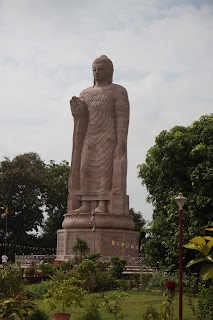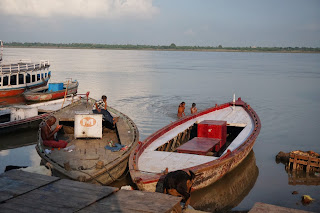After I showered, post Ganga sludge, I met up with the Brits that I mentioned earlier and we went to the nightly puja at the main ghat. The word puja refers generally to a Hindu religious ritual that serves as an offering. This particular puja has gained notoriety with Indian and Other tourists alike, and has become the event of the evening in Varanasi. After haggling with some boat men, we climbed aboard a boat to get a front row seat. There was lots of fire and smoke, and the boat men kept piling people onto the boats, which were tied together in a flotilla. We all joked that, after the ceremony was over, they would release the boats and we would float down the Ganga as offerings.
 |
| The flotilla of tourist captives. |
 |
| Smoke! |
 |
| Fire! |
 |
| Cute children! |
DAY 4
I chose the right day to head out of the city. The past two days had been misty and cloudy, thanks to a typhoon off the eastern coast of India, near Orissa. The weather headed out, thankfully, and I headed out of town to visit Sarnath, a little town famous for its archaeological ruins and Buddhist spirituality. After a 45-minute tuk-tuk ride and some seriously bruised kidneys, I arrived at a little junction with a museum, an archaeological site, and a beautiful garden temple. I chose to do the museum first.
As I walked in to the museum, I realized that I had never been to an Indian museum before. This one, however, was much like museums I had attended elsewhere, aside from some of the ubiquitous Indian grammatical errors on the informational plaques. There were really cool pieces of stonework and architecture from the nearby site, and gorgeous statues of bodhisattvas and the Buddha. It was quiet (and air conditioned!), and inexpensive.
After visiting the museum, I went to the actual archaeological site where, it is said, the Buddha gave his first sermon after he achieved enlightenment. Cool. There were vast temple ruins, and the remains of stupa, currently in the process of being restored. For those who may not know, a stupa is a monument, usually dome or bell-shaped, that houses relics to commemorate important persons or events. (Want more information? http://www.britannica.com/EBchecked/topic/570059/stupa.) This particular stupa, if I have my fact right, is where the Buddha first preached his sermon. As I walked around the ruins, picking my way through throngs of Buddhist tourists and worshippers, I tried to imagine the kind of temple that would have existed here. Here are some photos of the area:
I then headed over to the temple garden area, which was a wonderful respite from the tour groups and hasslers trying to sell me spinning Buddhas. The flowers were wonderful, the area was quiet, and the piece de resistance:
An 80-foot Buddha.
This is the tallest Buddha statue in the country, and was the result of an Indo-Thai partnership going back to 1970. It took 14 years to complete, beginning in 1997 and ending in 2011. It's a really beautiful statue in a gorgeous location, and I spent about an hour there, ambling through the gardens, taking pictures, and journaling.
This day was also the first time that I was asked to take a picture with a group of Indians. I've been officially tokenized!
After a little downtime at the hotel, I went back down to Assi Ghat to seek out some apple pie back at the pizzeria I found the day before. Thus begins one of my favorite memories in India so far:
Down at Assi Ghat, the sun was warm and soft, the breeze was refreshing, and everyone seemed to be under its spell. Even the touts were less aggressive, more lackadaisical. The far side of the Ganga was clear and green, the boats were bright in the late afternoon light. It was a magical time, with folks of all kinds sitting on the steps, chatting and eating aloo chaat. I sat by the water and watched a group of goats head-butt each other.
After a time, I went back to the pizzeria and ordered my apple pie. It arrived on a white plate with vanilla bean ice cream on top. I took a bite. Oh, my lord. What delicious apple pie. The crust was crumbly and crispy and had great taste, the apples were just the right texture, and the ice cream was juuuuust melty enough. For 70 rupees (about $1.20), I could have eaten them out of business.
DAY 5
My train was late arriving in the station and continued that trend throughout my journey, stretching my 21-hour ride to a whopping 27 hours. That's not really the important part, though. The important part is that I rode SLEEPER CLASS on the way back to school, and I had a blast.
Sleeper Class is the "dreaded" class of the train system for western tourists, and particularly (supposedly) for women. It's basically a huge open train car full of berths and no privacy. Admittedly, I have heard several horror stories (through the grapevine) of assaults, thefts, etc. I have also heard great things from women I know, traveling alone on sleeper class, and loving it! When I told people that I was riding sleeper class, they paused and said, "Huh. You're brave." Well, I'm not, really. I'm just poor, and I forgot to book a ticket in time.
I got on and realized that I was in a compartment full of men. That would have been awful, but the great thing about sleeper class is that the population ebbs and flows with each and every station, so the male domination was short-lived. Some highlights of the trip include:
The reeds that a nice man gave to me to create a jungle on my berth:
This ADORABLE BABY:
After the borderline miserably-long train ride, I finally arrived back in Mussoorie, tired and in serious need of a shower. After dinner and a drink, I settled in and realized: my first solo trip was a success!














No comments:
Post a Comment